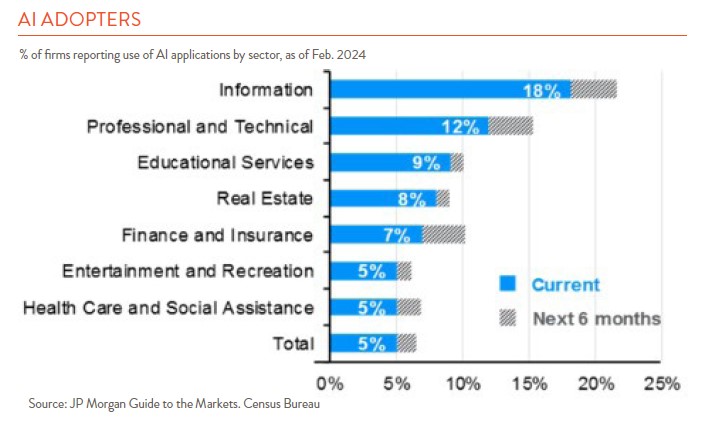ChatGPT, when first released back in late 2022, made a splash. AI technologies, and more specifically the large language models (LLMs) they are based on, had been around for years. But this AI chatbot was one of the first easy-to-use products capable of generating a range of written content in response to prompts – and it was made available to the public free of charge. Just two months after its release, an estimated one hundred million users had downloaded the software, making it the fastest growing consumer application in history.
So where does the technology stand today? ChatGPT has continued to gain a following – 180 million subscribers as of today. But investment in AI has expanded well beyond this product. Capital spending by the major U.S. AI-focused firms (Google, Microsoft, and Amazon, etc.) is expected to hit $183 billion this year, up over 45% from 2023 levels. Interestingly, companies are making these investments in the face of relatively low AI adoption rates across the economy. In a recent survey, The Center for Economic Studies, a division of the Census Bureau, found that just over 5% of all firms are actually using AI today (see chart below).

Experts today are split on AI’s long-term impact on the global economy. Optimists claim that the technology will transform work, boost productivity, and spur economic growth. Others, like MIT professor Daron Acemoglu, contend that truly transformative changes relating to AI will take time. And thanks to escalating costs, he expects that only a small portion of “AI exposed tasks” will make economic sense to automate. My guess is that AI will help achieve meaningful efficiencies over time, but the process will be more evolutionary than revolutionary. Some of the obstacles to wider AI adoption are listed below.
Talent: Firms across the economy are scrambling to find employees with the skills needed to integrate AI tools into their work processes. Job posting site Indeed recently reported a 20-fold increase in postings mentioning Gen(erative)AI. Many of these roles are familiar and involve traditional tasks like building and analyzing data sets. But jobs unique to AI, such as Prompt Engineer and Conversational AI Architect, are new. AI engineers with experience in specific sectors like healthcare or banking are also needed to customize the technology to specific business needs. Many firms are turning to outsourcing to meet the shortage of skilled workers while others are investing to retrain their existing workforce.
Energy: Generative AI models operate by parsing large datasets to recognize patterns in text, speech, or images. The more data they analyze, the greater the probability they have found a correct match. Improving accuracy is the “holy grail” of most AI models but requires a lot of energy. While estimates vary, a recent analysis published by Joule, a peer-reviewed scientific journal, estimates that at least 85.4 terawatts of electricity annually – more than what many small countries consume in a year – will be needed given current trends in AI capacity and adoption. Building and permitting electric generation and distribution facilities here in the U.S. has never been easy, and there are real questions as to whether the industry can scale quickly enough to meet this expected growth — especially given current carbon reduction-related regulatory constraints.
Regulation: So far, regulatory constraints have done little to restrict AI’s use, and what is in place varies across jurisdictions. But further regulation is likely and the related uncertainty has not been helpful to firms trying to implement AI. The EU is furthest along on the regulatory front, having recently passed an Act which included rules around data transparency, safety testing, and “incident” reporting. Over 500 different pieces of AI-related legislation have been filed in the U.S., but efforts here remain a work in progress.